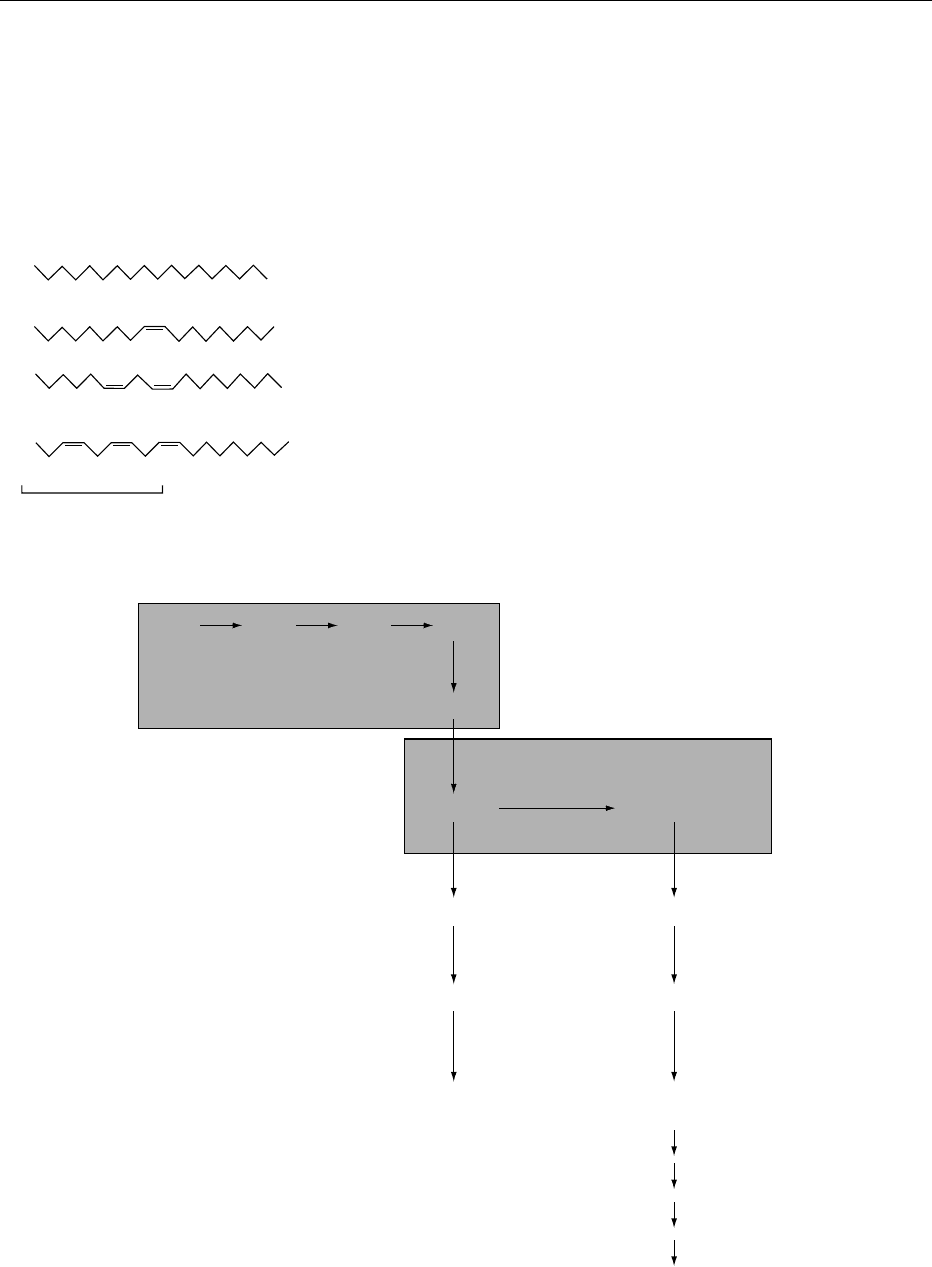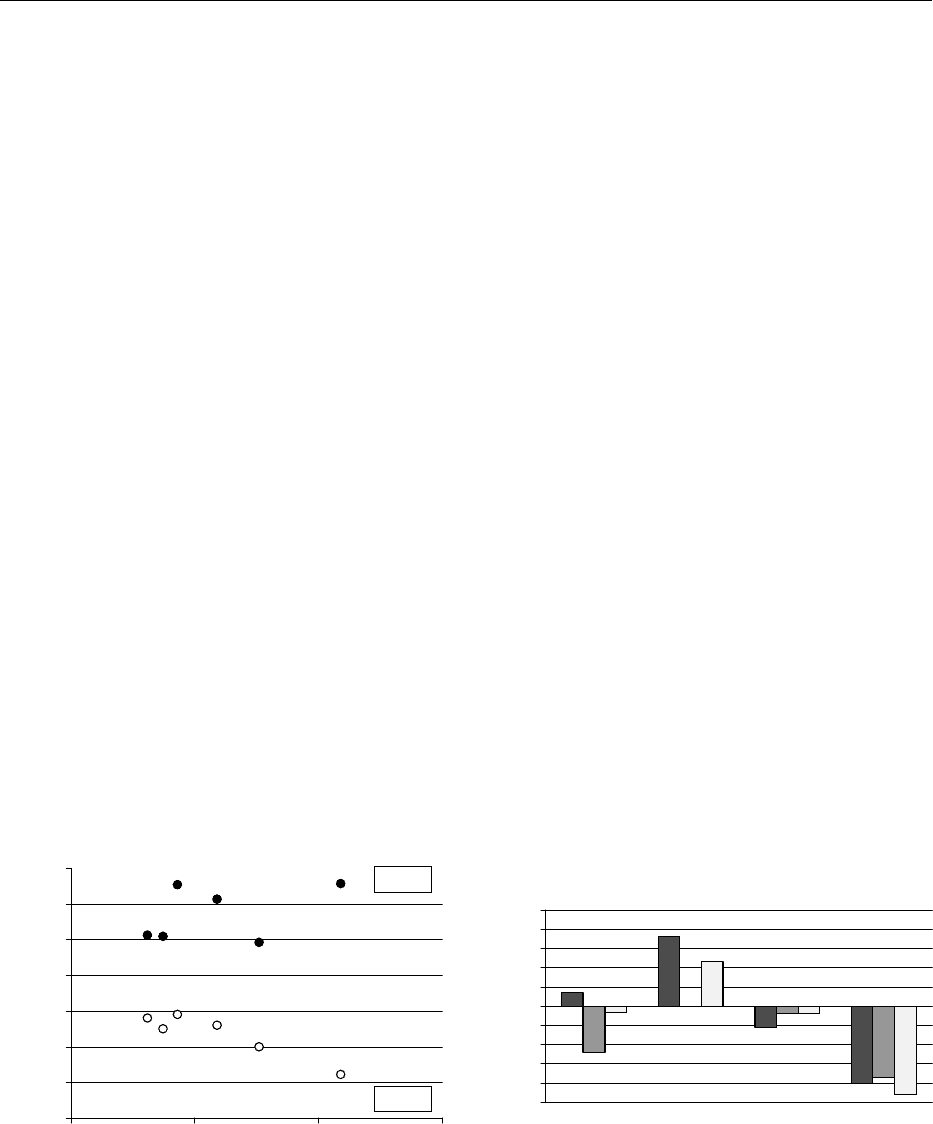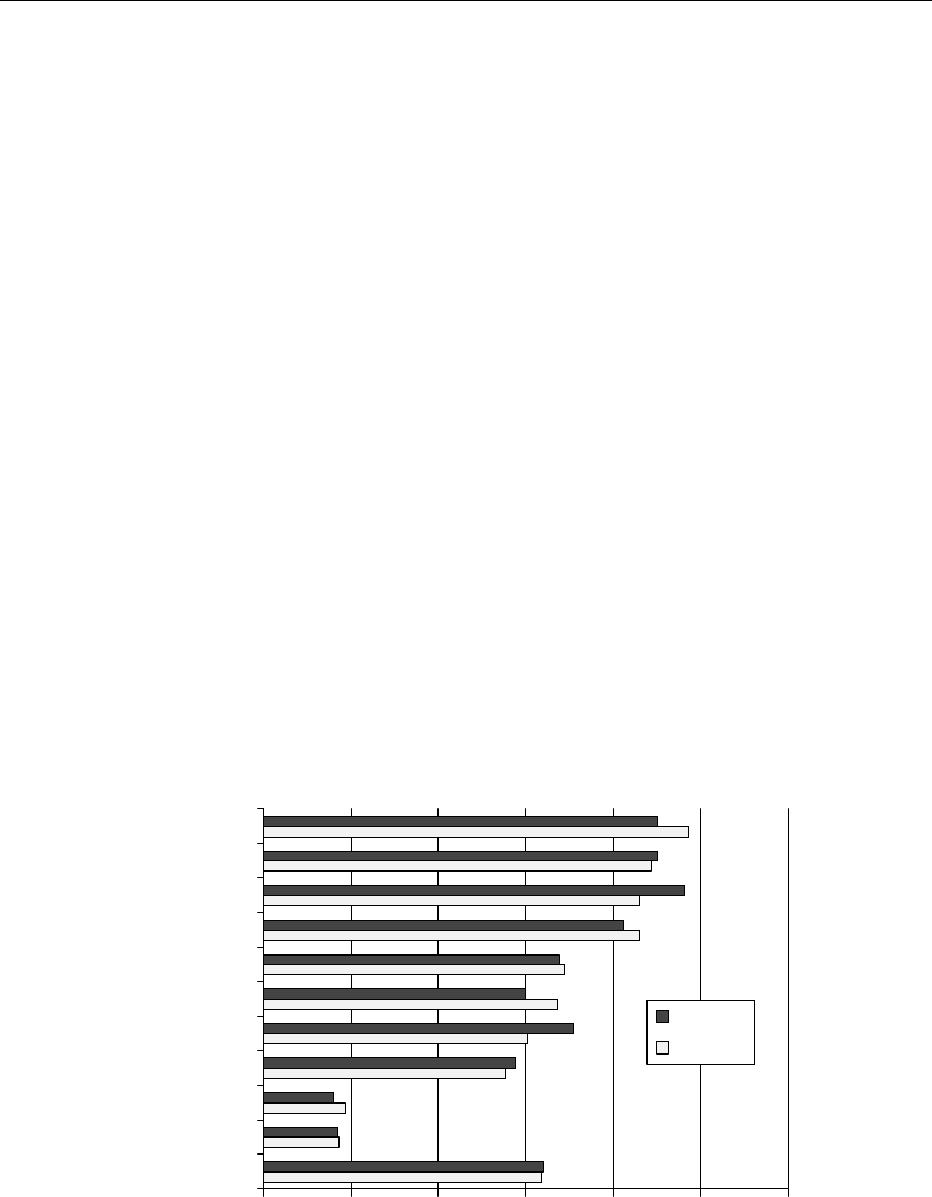Caballero B. (ed.) Encyclopaedia of Food Science, Food Technology and Nutrition. Ten-Volume Set
Подождите немного. Документ загружается.


than 95% of dietary fat. Each triacylglycerol mol-
ecule is composed of three fatty acids esterified to a
glycerol backbone, making fatty acids a major con-
stituents of dietary fat. In recent years, it has become
clear that fatty acids are more than just a source of
energy. Fatty acids, especially long-chain polyunsat-
urated fatty acids (PUFA), are important regulators of
many biological processes important in maintaining
health and preventing disease.
Types of Fat in the Diet
0002 Because of the wide range of foods consumed, the
human diet contains a great variety of fatty acids.
The chain length and degree of saturation are used
to classify fatty acids, and these characteristics confer
physiological properties. Fatty acids in the diet
can therefore be saturated fatty acids (SFA) and con-
tain no double bonds with the maximum number
of hydrogen molecules attached, monounsaturated
(MUFA) and contain a single double bond or PUFA
and contain two or more double bonds. All dietary
fats and oils contain a mixture of saturated and un-
saturated fatty acids. Individual fatty acids are often
referred to by their common names, but are more
correctly identified by a systematic nomenclature
that classifies them according to their chain length,
position and number of double bonds (Table 1). This
nomenclature indicates the number of carbon atoms
in the acyl chain of the molecule, followed by a colon
and then the number of unsaturated bonds. This is
followed by the letter ‘n’ (or o) and the number of
carbon atoms from the methyl end to the first double
bond. Mammalian cells are able to synthesize (from
nonfat precursors) saturated and unsaturated fatty
acids of the n-9 and n-7 series but lack the D-12 and
D-15 desaturase enzymes (which is found in most
plants) for insertion of a double bond at the n-6 or
tbl0001 Table 1 Nomenclature of fatty acids and major sources in the diet
Chemicalname Common name Fatty acidnotation Sources
Butanoic Butyric C4:0 Butter fat
Octanoic Caprylic C8:0 Palm kernel oil
Decanoic Capric C10:0 De-novo synthesis; coconut oil
Dodecanoic Lauric C12:0 De-novo synthesis; coconut oil
Tetradecanoic Myrsitic C14:0 De-novo synthesis; milk fat, coconut oil
Hexadecanoic Palmitic C16:0 De-novo synthesis and most plant and animal fats,
including milk, eggs, animal fats, meat, coca
butter, palm oil (other vegetable oils contain some
but lesser amounts), and fish oils
Octadecanoic Stearic C18:0 De-novo synthesis and most plant and animal fats,
including milk, eggs, animal fats, meat, and cocoa
butter
9-Hexadecenoic Palmitoleic C16:1n-7 Desaturation of palmitic acid, fish oils, animal fats
9-Octadecenoic Oleic C18:1n-9 Desaturation of stearic acid and all plant and animal
fats, including milk; eggs; animal fats; meat; cocoa
butter; most vegetable oils, especially olive oil
9,12-Octadecadienoic Linoleic C18:2n-6 Cannot be synthesized in mammals; some milks,
eggs, animal fats, meat; most vegetable oils,
especially corn, sunflower, safflower, cottonseed
and soybean oils; green leaves
9,12,15-Octadecatrienoic a-Linolenic C18:3n-3 Cannot be synthesized in mammals; green leaves;
some vegetable oils, especially canola, soybean,
walnut, mustard and linseed oils
6,9,12-Octadecatrienoic g-Linolenic C18:3n-6 Synthesized from linoleic acid, borage, blackcurrant
and evening primrose oils
11,14,17-Eicosatrienoic Mead C20:3n-9 Synthesized from oleic acid; indicator of essential
fatty acid deficiency
Eicosanoic Arachidic C20:0 De-novo synthesis; peanut oil
8,11,14-Eicosatrienoic Dihomo-g-linolenic C20:3n-6 Synthesized from g-linolenic
5,8,11,14-Eicosatetraenoic Arachidonic C20:4n-6 Synthesized from linoleic acid via g-linolenic and
dihomo-g-linolenic acids; small amount in meat
5,8,11,14,17-Eicosapentaenoic Eicosapentaenoic (EPA) C20:5n-3 Synthesized from a-linolenic acid; fish oils
7,10,13,16,19-Docosapentaenoic Docosapentaenoic C22:5n-3 Synthesized from a-linolenic acid via EPA; fish oils
and animal tissues (brain)
4,7,10,13,16,19-Docosahexaenoic Docosahexaenoic (DHA) C22:6n-3 Synthesized from a-linolenic acid via EPA; fish oils
and animal tissues (brain)
2318 FATTY ACIDS/Dietary Importance

n-3 position (Figure 1). As the two types of PUFA, n-6
and n-3 fatty acids, are essential substrates for many
of the regulatory lipids in the body, the precursor fatty
acids linoleic (18:2n-6) and a-linolenic (18:3n-3)
must be consumed in the diet (Figure 1). For the most
part, the longer chain and more unsaturated n-6 and
n-3 fatty acids such as arachidonic acid (20:4n-6),
eicosapentaenoic acid (EPA, 20:5n-3), and docosa-
hexaenoic acid (DHA, 22:6n-3) can be synthesized
from either linoleic or linolenic acid (Figure 2).
Sources of Fat in the Diet
0003The quantities and types of fatty acids ingested vary
greatly, depending on the dietary source (Table 1).
Animal fats contain about 40–60% saturated fatty
acids. Some plant oils also contain SFA (i.e., palm
oil, palm kernel oil, and coconut oil), which are
widely used in processed foods. MUFA are found in
animal fats and plant oils, with olive oil being a rich
source. Plant oils like corn, soybean, cottonseed, sun-
flower, and safflower generally have more than 50%
of their fatty acids as linoleic acid and are considered
excellent sources of PUFA. Poultry and game also
contain a small amount of linoleic acid. Linolenic
acid, which comprises the majority of most people’s
n-3 fatty acid intake, is found in high amounts in
Mammals cannot insert double bonds in these positions
H
3
C
H
3
C
H
3
C
H
3
C
Methyl end Carboxyl end
COOH
COOH
COOH
COOH
Stearic acid
18:0
Oleic acid
18:1 n-9
Linoleic acid
18:2 n-6
α-Linolenic acid
18:3 n-3
3
6
9
fig0001 Figure 1 Double-bond location in major dietary fatty acids.
12:0 18:016:014:0
18:1n-9
18:3n-318:2n-6
20:3n-6
20:4n-6
20:5n-3
22:6n-3
20:4n-3
18:3n-6 18:4n-3
∆9-desaturase
Diet or de novo synthesis
∆12-desaturase
not in humans
but found in plants
∆15-desaturase
plants only
Diet
∆6-desaturase
∆5-desaturase ∆5-desaturase
∆6-desaturase
Arachidonic acid
Eicosapentaenoic acid (EPA)
Docosahexaenoic acid (DHA)
fig0002 Figure 2 Elongation and desaturation of the major dietary fatty acids.
FATTY ACIDS/Dietary Importance 2319

several plant oils (e.g., canola and flax) and, to a
lesser extent, in other plant oils, green leafy vege-
tables, soybeans, and nuts. The more polyunsaturated
long-chain n-3 fatty acids, eicosapentaenoic acid
(EPA) and docosahexaenoic acid (DHA), comprise
20–30% of the fatty acids in cold water fish (particu-
larly fatty fish such as herring, mackerel, fresh tuna,
sardines, salmon, eel), other marine animals, and in
oils extracted from the livers of fish which live in
warmer waters (e.g., cod). There are new sources of
EPA and DHA, made from single cell organisms,
which are available to the food industry to supple-
ment food. Most natural fats contain fatty acids in the
cis form, but a small number of trans fatty acids also
occur naturally, principally in meat and dairy prod-
ucts. The majority of the trans fatty acids in the diet
come from foods made with hydrogenated vegetable
oils. Generally, most fruits and vegetables contribute
insignificant amounts or no fat to our diets.
Dietary Importance
0004 The dietary importance of fatty acids is listed in
Figure 3.
Energy and Essential Fatty Acids
0005 In addition to contributing to the texture, flavor, and
aroma of foods, fatty acids are an important concen-
trated source of energy (9 kcal or 37 kJ g
1
) for most
cells in the body. Fat is a particularly important
energy source for infants and young children, and
restriction is associated with poor growth and
delayed development. Although the biological
importance is not completely clear, there is evidence
suggesting that individual fatty acids are oxidized,
metabolized, stored, and released at different rates.
Fat slows down the digestion of foods, thus con-
tributing to meal satiety. Dietary fat aids in the
absorption of the fat-soluble vitamins. Specific fatty
acids have important structural, biochemical, and
regulatory functions that are required for optimal
tissue function, growth, and repair. Insufficient con-
sumption of the dietary essential fatty acids (linoleic
and linolenic acid) results in a deficiency syndrome
characterized by immune dysfunction, infections,
scaly dermatitis, growth retardation, hair loss, throm-
bocytopenia, diarrhea, and poor wound healing.
Membrane and Cellular Function
0006Fatty acids, particularly PUFA, when consumed in the
diet, integrate into cell membrane lipids. Although
membranes can vary in their lipid content, most cell
membranes contain approximately 50% lipid and
50% protein. Phospholipids, the major lipid found
in cell membranes, are particularly high in long-
chain (18–26-carbon) PUFA. The type of fatty acid
incorporated into cell membranes is influenced by
dietary fatty acids. It can be assumed that all of the
n-6 and n-3 fatty acids found in cell membranes are
derived from dietary sources. Changing the relative
amount and type of PUFA in cell membranes has been
shown to affect many membrane-related functions
such as membrane fluidity, ion channel flow, trans-
porter activity, signal transduction, enzyme activity,
hormone binding, cell-receptor action, cell-to-cell
communication, release of mediators, and suscepti-
bility to microbial invasion and cancer.
Eicosanoid Synthesis
0007Linoleic acid and a-linolenic acid are substrates for
the synthesis of physiological regulators called eicosa-
noids. Eicosanoids include prostaglandins, prostacy-
clins, thromboxanes, and leukotrienes. These ‘local
hormones’ are potent mediators of many biochemical
processes and play key roles in the regulation of blood
clots, blood pressure, blood lipid levels, immune
function, inflammation, pain and fever, and repro-
duction. The two major pathways for eicosanoid syn-
thesis are via the enzymes cyclooxygenase (produce
prostaglandins and thromboxanes) and lipooxygen-
ase (produce leukotrienes, hydroxyeicosatrienoic
acids, and lipoxins).
0008Dietary fat composition influences eicosanoid syn-
thesis by changing the supply of substrates for the
synthesis of the longer-chain n-3 and n-6 PUFA. Con-
suming large amount of linoleic acid increases the
quantity of arachidonic acid in cell membranes. Upon
activation, in a variety of cells, arachidonic acid is
converted to eicosanoids of the 2 series and leuko-
trienes of the 4 series. However, dietary a-linolenic
acid is converted to EPA in the membrane, and when
cells are activated, EPA is converted to eicosanoids of
the 3 series and leukotrienes of the 5 series. In general,
eicosanoids formed from n-3 PUFA oppose, or have
weaker effects than, eicosanoids formed from n-6
PUFA. In addition to competing as substrates for
cyclooxygenase, n-3 fatty acids can directly suppress
the activity of this enzyme. n-3 fatty acids also inhibit
D-6 and D-5 desaturase activity, reducing the synthe-
sis of arachidonic acid in the membrane. Indeed, it
has been shown that increasing the proportions of n-3
in relation to n-6 PUFAs in the diet decreases the
Energy
Source of essential fatty acids
Membrane structure & function
Gene regulation
Neurological and retinal
structure and function
Immune function
Disease prevention &
treatment
fig0003 Figure 3 Dietary importance of fatty acids.
2320 FATTY ACIDS/Dietary Importance

quantity of proinflammatory, vasoconstrictive, plate-
let aggregatory, and immunosuppressive compounds
that are regulated by eicosanoids. Recent investiga-
tions have shown that g-linolenic acid (20:3n-6)
present in some plants (i.e., evening primrose oil,
borage, and flaxseed) may also influence the type
of eicosanoid synthesized by a cell.
Gene Regulation
0009 PUFA have been shown to alter the expression of
numerous genes involved in the metabolic function
of the cell. It has been demonstrated that specific
dietary fatty acids can modulate the expression of a
variety of genes (and transcription regions on genes)
coding for key regulatory proteins in metabolic path-
ways such as those involved in digestion, lipogenesis,
glycolysis, glucose transport, inflammation, and cel-
lular communications. For example, dietary n-6 and
n-3 PUFA suppress hepatic lipogenesis by suppressing
transcription of fatty acid synthase. Suppression is
greater with DHA, EPA, and arachidonic acid than
with linoleic acid or a-linolenic acid, whereas SFA
and MUFA have little effect. In the future, fatty
acid–gene interactions will likely be translated to
dietary prescriptions to maintain health and modu-
late both the response to injury and the progression of
diseases in genetically susceptible individuals.
Neurological Development and Function
0010 DHA and arachidonic acid selectively accumulate
during fetal and infant brain development and are
found concentrated in the brain and retina. Fetal
accretion of these lipids occurs during the last trimes-
ter of gestation, and a deficiency can result in visual
impairment and brain dysfunction. Although DHA
and arachidonic acid can be synthesized from dietary
precursors, the efficiency of this conversion in young
infants (particularly preterm infants) may not be
sufficient to meet their high need. Postnatally,
human milk provides high amounts of both arachido-
nic acid and DHA to the infant, but the amount of
these lipids in milk can be influenced by the mixture
of fatty acids in the maternal diet. The preterm, and
perhaps fullterm, infant not fed mother’s milk may be
at risk of deficiency if these lipids are not provided.
Animal studies have clearly illustrated that provision
of arachidonic acid and DHA to young animals im-
proves visual and neurological function. Despite con-
siderable evidence of improved visual function in
formula infants provided DHA (and in some studies
also arachidonic acid), the dietary requirements for
these fatty acids in the infant vary greatly between
countries. Recently, animal studies have provided evi-
dence that DHA obtained from plasma is involved
both in dopamine and serotonin metabolism in the
brain and in the retina for the function of rhodopsin.
These findings should guide clinical studies to more
sensitive measures of the functional roles of dietary n-
3 fatty acids. At present, there are promising prelim-
inary results regarding the efficacy of treating various
visual disorders and forms of depression with dietary
DHA.
Immune Function
0011There is now considerable scientific evidence, from
animal and human studies, that the amount and type
of fatty acids in the diet can modulate immune func-
tion. A deficiency of either n-6 or n-3 essential fatty
acids is associated with a reduced immune function.
Amongst the fatty acids, the n-3 fatty acids possess
the most potent immunomodulatory activities, and
amongst the n-3 fatty acids, those from fish oil (EPA
and DHA) are more potent than a-linolenic acid. In
particular, it has been demonstrated that feeding
DHA and EPA (often in a mixture of ‘immunoactive’
nutrients) decreases the rate of infections and im-
proves outcome (i.e., reduced complications, length
of stay, hospital cost) in immunosuppressed patients.
These effects are likely mediated through mechanisms
that involve indirect (i.e., via eicosanoids, hormone
action) and direct (regulation of transcription factors)
effects on genes in immune cells.
0012Many of the detrimental and lethal effects of infec-
tion and injury (especially detrimental effects) are
mediated by the proinflammatory cytokines (e.g.,
tumor necrosis factor a (TNF-a), interleukin (IL)-1
and IL-6) and eicosanoids. Thus, a reduction in the
synthesis of proinflammatory mediators would be
beneficial during critical illness and autoimmune
states. In both clinical trials and animal studies, feed-
ing DHA and EPA has been demonstrated to decrease
the expression of proinflammatory cytokines, genes,
eicosanoids, and adhesion molecules, whereas n-6
PUFAs increase the expression of proinflammatory
genes. These observations have formed the basis for
successful interventions with oral EPA and DHA to
treatacuteandchronicinflammation,andfordisorders
that involve an inappropriately activated immune
response (i.e., inflammatory bowel disease, rheuma-
toid arthritis, psoriasis, asthma, multiple sclerosis,
systemic lupus erythematosus, and atopic dermatitis).
0013A number of studies have also reported suppressed
cell-mediated immunity, but not generally humoral
immunity, in humans or animals fed very high levels
of DHA and EPA. One might conclude that consump-
tion of long-chain n-3 PUFA might be contraindicated
in those with poorly functioning immune systems.
However, the very low level of DHA and EPA and
the high level of linoleic acid currently in the diet of
most people questions the physiological relevance of
FATTY ACIDS/Dietary Importance 2321

n-3 immunosuppression in a healthy individual. To
support this, there are many studies reporting benefits
to the immune system when EPA/DHA are fed to
immunosuppressed individuals, such as those with
cancer or recovering from surgery. This suggests that
the effect of n-3 PUFA on immune function may
depend on the composition and content of other
fatty acids in the diet.
Disease Prevention and Treatment
0014 Epidemiological studies have concluded that con-
sumption of different amounts and types of fatty
acids over a lifetime can alter the risk for many chronic
diseases (e.g., heart disease, cancer). There is also
scientific evidence to support that dietary fatty acid
composition can be used in the prevention/treatment
of diseases such as coronary heart disease (CHD) and
cancer. Both n-6 and n-3 PUFA have been shown to be
of potential benefit in the treatment of acute respira-
tory distress syndrome and asthma. Beneficial effects
of feeding n-3 fatty acids have been shown in the
secondary prevention of CHD, hypertension, type 2
diabetes, and, in some patients with renal disease,
rheumatoid arthritis, inflammatory bowel diseases,
and chronic obstructive pulmonary disease.
0015 Coronary heart disease Individual fatty acids differ
in their ability to change blood cholesterol and lipo-
protein levels, two major risk factors for CHD.
0016 SFA For the past 30 years, epidemiological and ex-
perimental studies have found that the consumption
of a high SFA diet increases low-density lipoprotein
(LDL)-cholesterol levels, a major risk factor for
CHD. The precise mechanism for these effects has
not been established, but high intakes of SFA decrease
the removal of plasma LDL by LDL receptors, and
they may promote endogenous cholesterol synthesis.
More recently, studies have found that SFA have
varying effects on plasma lipid levels, depending on
their chain length. Much of this work has been
carried out on animals, and there is considerable
controversy as to the effect of stearic, palmitic,
myristic, and lauric acids on plasma lipid levels and
cholesterol synthesis. It is likely that the deleterious
effect of SFA on CHD in epidemiological studies is
explained by the hypercholesterolemic effects of myr-
istic, palmitic, and perhaps also lauric acid. There are
less data to support a hypercholesterolemic effect of
consuming stearic acid. Recently, research has sug-
gested that the cholesterol-raising properties of myr-
istic and palmitic acid may be related to the intake of
PUFA, such that, when PUFA falls below a threshold
intake (around 5% of energy), the cholesterol-raising
properties of these SFA are greatly augmented.
0017MUFA Generally, studies have found that popula-
tions that consume high MUFA diets have a lower
risk of CHD. Clinical and animal studies have con-
firmed that consumption of MUFA (i.e., oleic acid) is
associated with lower total- and LDL-cholesterol
levels and higher high-density lipoprotein (HDL)-
cholesterol levels. Consumption of MUFA has also
been reported to increase LDL-receptor activity.
0018n-6 PUFA Epidemiological studies report that
populations that consume 10% of their fats as linoleic
acid have a lower risk of developing CHD. A lower
dietary ratio of PUFA/SFA is associated with higher
plasma cholesterol concentrations and a higher popu-
lation risk of CHD. In clinical studies, it has been
shown that consumption of linoleic acid decreases
the synthesis of cholesterol in the body and increases
LDL-receptor activity, resulting in lower total- and
LDL-cholesterol levels. Most countries’ dietary
recommendations have attempted to promote an
increase in the intake of n-6 PUFA for its beneficial
effects on reducing the risk of CHD. However,
some studies have also indicated that a high intake
of n-6 fatty acids (much higher than the current rec-
ommendation of 10% of energy) may reduce HDL-
cholesterol levels and shift the physiologic state to one
that is prothrombotic and proaggregatory, changes
that are associated with an increased risk of CHD.
0019n-3 PUFA Epidemiological studies conclude that the
incidences of CHD and atherosclerosis are inversely
associated with consumption of n-3 PUFA, particu-
larly EPA. The antiatherosclerotic actions of n-3
PUFA have been supported in animal and human
clinical trials. Experimentally, it has been demon-
strated that consumption of n-3 fatty acids (a-lino-
lenic, DHA, or EPA) reduced plasma triacylglycerol
levels (very-low-density lipoprotein-triacylglycerols),
a risk factor for heart disease (especially in women).
Evidence for the beneficial effects of consuming n-3
PUFA on blood triacylglycerols, blood pressure, car-
diac and vascular function, eicosanoids, coagulation,
and immunological responses has prompted many
health agencies to recommend increasing the intake
of these fatty acids to reduce the risk of CHD. There is
still, however, a high degree of uncertainty in defining
both the type and amount of n-3 PUFA that is
considered preventative. In a recent metaanalysis of
studies examining the relationship between fish con-
sumption and CHD, it was concluded that consump-
tion of 40–60 g of fish each day was associated with a
markedly reduced CHD mortality in high-risk popu-
lations but not in low-risk populations. In cardiac
patients, there are reports of beneficial effects of
ingesting oily fish on the incidence of bypass graft
2322 FATTY ACIDS/Dietary Importance

occlusions, forearm vasodilation, arrhythmias, non-
fatal stroke, nonfatal myocardial infarction, and
cardiac death. There is also increasing evidence for
an antiarrhythmic action of n-3 PUFA in humans.
Most of the studies in high-risk populations have
been carried out by feeding fish oils (EPA and
DHA), and less is known about the effects of their
plant-derived precursor, a-linolenic acid.
0020 Trans-fatty acids A high consumption of trans-
fatty acids is associated with an increase in LDL-
cholesterol and a decrease in HDL-cholesterol, two
changes that would increase the risk of CHD. Trans-
fats account for about 2–8% of the calories in our
diets, compared with 12–14% for saturated fats. Cur-
rently, most nutritionists and researchers recommend
that hydrogenated fats containing trans-fatty acids be
limited or reduced in the diet.
0021 Cancer Human epidemiological and experimen-
tal studies have established a positive relationship
between high (mainly SFA) intake and cancer. How-
ever, high intakes of SFA or n-6 PUFA increase the
growth of tumors in several animal models, while
decreasing the n-6/n-3 ratio (by increasing the intake
of n-3 fatty acids) has been shown to inhibit the
growth and metastasis of rodent tumors. There is
convincing evidence that both DHA and EPA can
inhibit the growth of cancer cells (breast and colon)
both in vitro and in explants. It has been suggested
that the n-6/n-3 ratio of the diet, rather than the
absolute intakes of these PUFA, may define cancer
risk. Possible mechanisms include both direct effects
on tumor growth and indirect effects on anticancer
immune defenses. Although many studies support a
recommendation to decrease the n-6/n-3 ratio in the
diet, most cancer agencies do not yet feel that there
are sufficient human data to make recommendations
to the population. Current recommendations to pre-
vent cancer have been aimed at promoting a decrease
in dietary fat intake, focusing on reducing the intake
of SFA. There are currently no specific fatty acid
recommendations for those with, or recovering from,
cancer. There are data to support beneficial effects of
supplementing individuals with DHA/EPA. These
benefits include reducing tumor growth, improving
anticancer immune defenses, improving the response
to surgery, chemotherapy, and radiation treatments,
and decreasing cachexia-mediated weight loss.
Estimated Intakes and Recommendations
for Fatty Acids in the Diet
0022Quantitative dietary guidelines for fats were first
issued in the late 1970s and have changed relatively
little since that time. Current recommendations for
total fat in the diet of adults by most Western coun-
tries is less than or equal to 30% of energy. The lower
limit of fat intake to meet the energy needs of adults is
assumed to be between 10 and 15% of dietary energy,
provided that enough carbohydrates are available.
This minimum level depends on the fat requirement
to meet energy needs, the need for essential fatty
acids, and the amount of fat in the diet that is neces-
sary to absorb fat-soluble vitamins (particularly vita-
mins A and E). Most countries recommend that the
intake of SFA should not exceed 10% of the energy
intake, PUFA should comprise about 10% of energy
and the remainder of the intake of fat be comprised of
MUFA. A comparison of dietary fat and fatty acid
recommendations between several countries is shown
in Table 2.
SFA and MUFA
0023In the past 30 years, the absolute consumption of
SFA in Western diets has declined. For example, in
the UK, SFA intake has declined by 40%. Based on
the lower risk of some chronic diseases in Mediterra-
nean countries, where the population consumes
diets high in MUFA, it is generally recommended
that the population replace SFA with MUFA. How-
ever, since 1970, the intake of MUFA in the UK has
declined by 30%.
tbl0002 Table 2 Dietary fat recommendations from selective countries around the world
Country Total fat (percentage of energy) SFA (percentage of energy) MUFA (percentage of energy) PUFA (percentage of energy)
UK 33 10 None stated 6–10
Canada <30 10 None stated >3.5
USA 30 10 None stated None stated
Japan 20–25 6–8 8–10 6–8
New Zealand 30–35 12 20 8
Iceland 25–30 15 None stated None stated
Malaysia 20–30 10 10 10
Singapore 20–30 10 10 10
Source: Inform (2001) International News of Fats, Oils and Related Materials 12(2): 132–140, published by the AOCS Press.
FATTY ACIDS/Dietary Importance 2323

PUFA
0024 For adults, the recommended intake for essential
fatty acids is in the range of 3–5% of dietary energy
for linoleic acid, and 0.5–1.0% of dietary energy for
linolenic acid (about 1–4 g day
1
). During the past 60
years, in the UK, the consumption of PUFA has in-
creased by 25%, despite a decrease in total fat intake.
This was likely contributed to by the increased con-
sumption of linoleic acid in margarines and various
plant oils (sunflower, safflower, cottonseed, soybean,
canola). Estimated intakes of PUFA are similar in
North America, with the exception that the intake
of n-3 fatty acids may be lower than in the diet of
those in the UK. This increased intake of linoleic acid
(approximately 10–14 g day
1
) over the past decades
has changed the balance between n-6 and n-3 fatty
acids in the diet. Dietary intake studies, in developed
countries, estimate that the dietary n-6/n-3 fatty acid
ratio approaches 14:1–20:1. However, most studies
suggest that a ratio between 4:1 and 10:1 is needed to
achieve the health benefits associated with consump-
tion of n-3 fatty acids.
0025 Despite the health benefits of n-3 PUFA, the mean
daily intake falls far short of any current recommen-
dation. The intake of DHA and EPA in most de-
veloped countries is small and related to the intake
of fatty fish, and so promoting fish consumption is the
most obvious way to increase n-3 PUFA intake. In
North America, it is recommended that people should
have at least two servings of fish per week. On a
cautionary note, PUFA are oxidized more readily
than SFA and MUFA and may increase the suscepti-
bility of cellular membranes to lipid peroxidation.
Indeed, increased free-radical production has been
demonstrated in animals fed diets rich in n-3 PUFA.
Consuming additional antioxidants such as vitamin E
can minimize oxidation risk.
Conclusions and Summary
0026 Fat contributes more than a third of the energy in the
diet of most people. Fat comprises a number of differ-
ent fatty acids varying in carbon chain length and
degree of saturation. Specific dietary fatty acids have
many essential roles in the body in addition to pro-
viding an energy-efficient fuel. Changing the types or
fatty acids in the diet changes the composition and
function of membranes, eicosanoid synthesis, regu-
lates gene expression, controls neurological and retinal
development, and modulates immune function in
health and disease. There is considerable research
demonstrating the importance of n-3 PUFA or the
n-6/n-3 PUFA ratio in the prevention and treatment
of CHD and cancer. Onthe basis of current knowledge,
an increase in the consumption of long-chain n-3 fatty
acids seems a prudent recommendation. In summary,
dietary fatty intake represents a major environmental
factor affecting optimal growth, development, re-
sponse to injury, and overall health in the population.
See also: Cancer: Diet in Cancer Prevention; Diet in
Cancer Treatment; Fats: Requirements; Fatty Acids:
Properties; Metabolism; Gamma-linolenic Acid; Fats:
Classification
Further Reading
Calder PC (1999) Dietary fatty acids and the immune
system. Lipids 34 (Supplement): S137–S140.
Calder PC and Deckelbaum RJ (1999) Dietary lipids: more
than just a source of calories. Current Opinion in
Clinical Nutrition & Metabolic Care 2: 105–107.
Gibney MJ (1999) Strategies for altering population intakes
of fats and fatty acids. Proceedings of the Nutrition
Society 58: 189–191.
Hamosh M and Salem N, Jr. (1998) Long-chain polyunsat-
urated fatty acids. Biology of the Neonate 74: 106–120.
Innis SM (2000) The role of dietary n-6 and n-3 fatty acids
in the developing brain. Developmental Neuroscience
22: 474–480.
Marckmann P and Gronbaek M (1999) Fish consumption
and coronary heart disease mortality. A systematic
review of prospective cohort studies. European Journal
of Clinical Nutrition 53: 585–590.
Milner JA and Allison RG (1999) The role of dietary fat in
child nutrition and development: summary of an ASNS
workshop. American Society for Nutritional Sciences.
Journal of Nutrition 129: 2094–2105.
Mori TA and Beilin LJ (2001) Long-chain omega 3 fatty
acids, blood lipids and cardiovascular risk reduction.
Current Opinion in Lipidology 12: 11–17.
Roche HM (1999) Unsaturated fatty acids. Proceedings of
the Nutrition Society 58: 397–401.
Simopoulos AP (1999) Essential fatty acids in health and
chronic disease. American Journal of Clinical Nutrition
70: 560S–569S.
Uauy R and Valenzuela A (2000) Marine oils: the health
benefits of n-3 fatty acids. Nutrition 16: 680–684.
Trans
-fatty Acids: Health
Effects
A Aro, National Public Health Institute (KTL), Helsinki,
Finland
Copyright 2003, Elsevier Science Ltd. All Rights Reserved.
Effects on Serum Lipoproteins
0001Early studies on the effects of trans-fatty acids on
serum total cholesterol levels in human subjects gave
conflicting results. Studies in experimental animals
2324 FATTY ACIDS/
Trans
-fatty Acids: Health Effects

like rats, mice, and pigs did not show any appreciable
difference between the effects on serum cholesterol of
partially hydrogenated vegetable oils and nonhydro-
genated oils. Therefore, the common impression was
that trans-fatty acids were not hypercholesterolemic
or that their effect on serum cholesterol concentration
was weak and clinically not important. This impres-
sion was not changed until studies focusing attention
separately on low-density lipoprotein (LDL) and
high-density lipoprotein (HDL) became available in
the 1990s.
0002 Since 1990, several dietary intervention trials have
indicated that, when compared with oleic acid, trans-
fatty acids from partially hydrogenated vegetable oils
or fish oils increase serum LDL-cholesterol and tend
to reduce HDL-cholesterol in a dose-dependent
manner (Figure 1). The increase in LDL-cholesterol
has been apparent in all studies, but without a clear
dose-effect. The HDL-cholesterol concentration has
showed little change by small doses of trans-fatty
acids, but higher amounts, in the order of 6–11% of
energy, have clearly reduced HDL-cholesterol con-
centrations in a dose-dependent manner. In most
studies, the LDL-cholesterol-raising effect has been
somewhat weaker than that of equal amounts of
C12–16 saturated fatty acids, but this may partly
depend on short study periods. Corresponding effects
on serum apoproteins, an increase in apoprotein B
and a decrease in apoprotein A-I concentration,
have been found in those studies where apoprotein
concentrations have been measured. In some studies,
an increase in serum triglycerides has been observed
but the effect has been weak and generally statistic-
ally nonsignificant.
0003Partially hydrogenated fish oils that are used in
some countries like Iceland and Norway and were
previously also consumed in other north-western
European countries seem to have a more powerful
effect on serum lipoproteins than trans-fatty acids of
vegetable origin (Figure 2). The isomeric composition
of C18:1 trans-fatty acids is rather similar in partially
hydrogenated vegetable and fish oils, but the various
long-chain C20–22 trans-isomers that are formed
when fish oils are chemically hydrogenated may
have an exceptionally strong LDL-cholesterol-raising
effect. The effect on lipoproteins of the delta-11
isomer trans-vaccenic acid, the main trans-isomer of
animal fats, has not been studied separately from
other fatty acids, because pure preparations have
not been available for this purpose. The effects of
different C18:1 trans-isomers may vary, because the
isomers are metabolized by different routes. Trans-
vaccenic acid is desaturated to conjugated linoleic
acid (CLA) by the delta-9-desaturase, whereas the
main isomers of partially hydrogenated vegetable
and fish oils, the delta-9-(elaidic acid) and delta-
10-isomers, cannot be metabolized by this pathway.
The effects of CLA on the risk of coronary heart
disease (CHD) are poorly known, but some CLA-
isomers may have antiatherogenic properties
according to experimental studies in animals. Infor-
mation on the metabolism of trans-fatty acid isomers
is limited. Generally, the trans-isomers seem to be
metabolized by the same pathways as the correspond-
ing cis-isomers.
−0.3
−0.2
−0.1
0
0.1
0.2
0.3
0.4
0510
Cholesterol (mmol l
−1
)
15
Trans - C18:1 (% of energy)
LDL
HDL
fig0001 Figure 1 Effects on serum low-density lipoprotein (LDL)-
cholesterol (closed symbols) and high-density lipoprotein
(HDL)-cholesterol concentrations (open symbols) of trans-fatty
acids from partially hydrogenated vegetable oils as compared
with oleic acid in six controlled dietary trials. Data from Katan
MB, Zock PL and Mensink RP (1995) Tr a n s fatty acids and their
effects on lipoproteins in humans. Annual Review of Nutrition 15:
473–493.
−0.5
−0.4
−0.3
−0.2
−0.1
0
0.1
0.2
0.3
0.4
0.5
Cholesterol LDL-chol HDL-chol Triglycerides
mmol l
−1
fig0002Figure 2 Effects on serum and lipoprotein lipids by 3-week
feeding of partially hydrogenated fish oil (dark columns), partially
hydrogenated vegetable oil (gray columns), and butter (light
columns). The columns indicate changes from a customary Nor-
wegian background diet. LDL-chol, low-density-lipoprotein chol-
esterol; HDL-chol, high-density lipoprotein cholesterol. Data from
Almendingen K, Jordal O, Kierulf P, Sandstad B and Pedersen JI
(1995) Effects of partially hydrogenated fish oil, partially hydro-
genated soybean oil, and butter on serum lipoproteins and Lp[a]
in men. Journal of Lipid Research 36: 1370–1384.
FATTY ACIDS/
Trans
-fatty Acids: Health Effects 2325

0004 In the clinical trials with partially hydrogenated
vegetable oils and fish oils, amounts of trans-fatty
acids (3–10% of energy) have been used that are
higher than the habitual consumption in most coun-
tries. The trans-fatty acids have been derived from
specially designed products high in trans-fatty acids
and not from commonly available foods. Therefore it
is difficult to estimate the effects of the amounts that
are habitually consumed by people in western coun-
tries as part of their diets. Studies on the composition
of foods have revealed that processed foods that
contain trans-fatty acids often contain more cis-
unsaturated fatty acids than the corresponding foods
that are based on saturated animal fats. As an
example, icecream that is manufactured from par-
tially hydrogenated vegetable oil contains more cis-
unsaturated fatty acids than icecream based on milk
fat or coconut oil. Thus the effects of moderate
amounts of trans-fatty acids may be balanced by the
neutral or LDL-cholesterol-reducing effects of the
concomitant cis-unsaturated fatty acids of the same
foods.
Trans
-Fatty Acids and Risk of Coronary
Heart Disease
0005 The observed effects of dietary trans-fatty acids on
serum lipoproteins, an increase in LDL-cholesterol
concentration combined with a reduction in HDL-
cholesterol, are expected to increase the risk of
CHD. The associations between trans-fatty acid
intake and risk of CHD have been studied in several
case-control studies and cohort studies. Some studies
have supported the concept of increased risk of CHD
by high consumption of trans-fatty acids, but the
results have been somewhat controversial.
0006In most case-control studies the fatty acid compos-
ition of adipose tissue or serum has been used as an
indicator of trans-fatty acid intake. In three studies,
C16:1 trans-fatty acids that are mainly derived
from fats of animal origin were higher in cases
than in control subjects, but in other studies the
C16:1 trans-isomers did not show significant associ-
ations with the risk of CHD. In six of the studies, no
significant case-control difference was found in
C18:1 trans-fatty acids. One study showed a direct
association between C18:1 trans-fatty acids in plate-
let phospholipids and risk of CHD, and one study
showed an inverse association between C18:1 trans-
fatty acids in adipose tissue and risk of sudden cardiac
death. One study from the USA, based on food intake
data, showed an increased relative risk of CHD in the
highest quintile of trans-fatty acid intake but a de-
creased risk in the third quintile, representing moder-
ate intake. In the largest of the case-control studies,
the multicenter EURAMIC study, adipose tissue
samples from 671 male survivors of a first acute
myocardial infarction and from 717 reference men
were studied. No overall case-control difference was
found in C18:1 trans-fatty acids (Figure 3). The
0 0.5 1 1.5 2 2.5 3
All countries
Spain (Granada)
Spain (Malaga)
Germany
Finland
Russia
Switzerland
Israel
Norway
Scotland
Netherlands
Cases
Controls
Adipose tissue C18:1 trans-fatty acids (%)
fig0003 Figure 3 Mean proportions of adipose tissue C18:1 trans-fatty acids in male survivors of a first myocardial infarction (cases) and
male control subjects without coronary heart disease (controls) in the nine countries of the European multicenter, case-control
EURAMIC study conducted in 1991–92. Data from Aro A, Kardinaal AFM, Salminen I et al. (1995) Adipose tissue isomeric trans fatty
acids and risk of myocardial infarction in nine countries: the EURAMIC study. Lancet 345: 273–278.
2326 FATTY ACIDS/
Trans
-fatty Acids: Health Effects

case-control differences differed between the coun-
tries. In Norway and Finland, cases with acute myo-
cardial infarction had significantly higher
proportions of trans-fatty acids in the adipose tissue
than control subjects. In Russia and one of the Span-
ish centers, a significant difference in the other direc-
tion was found. The results showed up to sixfold
differences between the countries in adipose tissue
trans-fatty acids, suggesting large differences in the
average dietary intakes of trans-fatty acids between
the nine participating countries.
0007 The differences in dietary intakes were subse-
quently confirmed by the TRANSFAIR study in 14
European countries. When the two Spanish centers of
the EURAMIC study that showed very low propor-
tions of C18:1 trans-fatty acids in the adipose tissue
were excluded, the results suggested a borderline sig-
nificant increase in the relative risk of CHD in the
two highest quartiles of adipose tissue C18:1 trans-
fatty acids compared with the lowest quartile. The
C18:1 trans-fatty acids are the largest and clinically
most important cluster of trans-fatty acids. The C16:1
trans-fatty acids are a minor component mainly
derived from ruminant animal fats. Different cis/
trans-isomers of C18:2 are derived in relatively
small quantities from both partially hydrogenated
vegetable oils and ruminant animal fats. Epidemi-
ological studies do not suggest any major impact on
the risk of CHD by these small trans-fatty acid
clusters.
0008 The discordant results of the case-control studies
seem to reflect more analytical problems, problems in
interpreting the fatty acid composition of tissues, and
difficulties in distinguishing between the causes and
effects of the disease in subjects with diagnosed CHD
than real effects on the risk of CHD. The differing
results may also indicate that trans-fatty acids in
tissues are markers of some other associated factors
that have more impact on CHD risk than the small
amounts of trans-fatty acids in the diet. Overall, the
results seem to agree with the concept that the current
average intakes of trans-fatty acids are too low to
have a significant effect on CHD risk.
0009Four cohort studies have addressed the association
between the intake of trans-fatty acids measured
either with semiquantitative food-frequency ques-
tionnaires or modified dietary history methods.
All these studies showed a significantly increased
relative risk of CHD in the highest quintile or tertile
of trans-fatty acid intake compared with the lowest
(Table 1). The increased risk was associated with
high intakes of C18:1 trans-fatty acids only, whereas
moderate intakes were not significantly associated
with the risk of CHD. In the female and male
cohorts from the USA and in the male ATBC study
cohort from Finland, the mean intake of trans-fatty
acids in the highest quintile was between 1.6 and
2.9% of energy intake. In the Dutch Zutphen elderly
study, the median intake of the highest tertile was
much higher – 6.4% of energy intake. The results of
the two US studies suggested that the increased risk
of CHD was due to trans-fatty acids from partially
hydrogenated vegetable oils only, whereas in the
Dutch study, no difference between the risk effects
tbl0001 Table 1 Multivariate
a
relative risk (RR) and 95% confidence intervals (CI) of coronary heart disease in cohort studies in relation to
trans-fatty acid intake
Intake of trans-fattyacids
Quintile 1 (low) Quintile 2 Quintile 3 Quintile 4 Quintile 5 (high)
Nurses’ Health Study (Hu et al., 1997)
b
No. of cases 939
RR (95% CI) 1.0 1.07 (0.86–1.33) 1.10 (0.89–1.37) 1.13 (0.91–1.39) 1.27 (1.03–1.56)
Health Professionals
Follow-upStudy(Ascherioetal.,1996)
b
No. of cases 112 140 147 154 181
RR (95% CI) 1.0 1.12 (0.86–1.44) 1.12 (0.87–1.44) 1.12 (0.86–1.46) 1.21 (0.93–1.58)
ATBCstudy(Pietinenetal.,1997)
b
No. of cases 244 288 268 297 302
RR (95% CI) 1.0 1.10 (0.93–1.31) 0.97 (0.82–1.16) 1.07 (0.90–1.28) 1.14 (0.95–1.35)
Tertile 1 (low) Tertile 2 Tertile 3 (high)
Zutphen elderly study (Oomen et al., 2001)
b
No. of cases 24 30 44
RR (95 CI) 1.0 1.34 (0.76–2.37) 2.00 (1.07–3.75)
a
Adjusted for various risk factors of coronary heart disease.
b
Oomen CM, Ocke
´
MC, Feskens EJM et al. (2001) Tr a n s fatty acid intake is associated with an increased 10-year risk of coronary heart disease in the
Zutphen Elderly Study. Lancet 357: 746–751.
FATTY ACIDS/
Trans
-fatty Acids: Health Effects 2327
